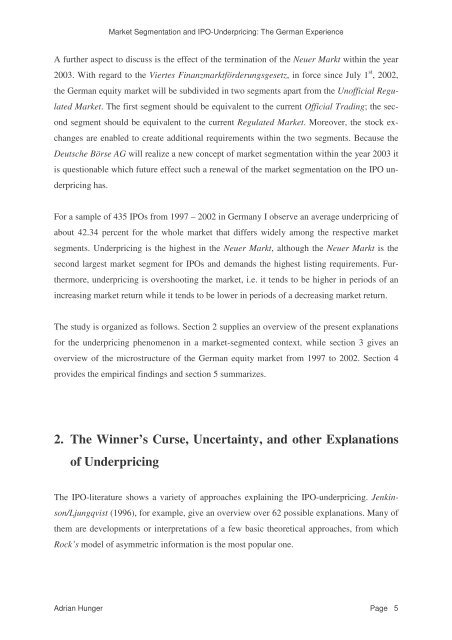Market Segmentation and IPO-Underpricing: The German Experience
Market Segmentation and IPO-Underpricing: The German Experience
Market Segmentation and IPO-Underpricing: The German Experience
You also want an ePaper? Increase the reach of your titles
YUMPU automatically turns print PDFs into web optimized ePapers that Google loves.
<strong>Market</strong> <strong>Segmentation</strong> <strong>and</strong> <strong>IPO</strong>-<strong>Underpricing</strong>: <strong>The</strong> <strong>German</strong> <strong>Experience</strong><br />
A further aspect to discuss is the effect of the termination of the Neuer Markt within the year<br />
2003. With regard to the Viertes Finanzmarktförderungsgesetz, in force since July 1 st , 2002,<br />
the <strong>German</strong> equity market will be subdivided in two segments apart from the Unofficial Regu-<br />
lated <strong>Market</strong>. <strong>The</strong> first segment should be equivalent to the current Official Trading; the sec-<br />
ond segment should be equivalent to the current Regulated <strong>Market</strong>. Moreover, the stock ex-<br />
changes are enabled to create additional requirements within the two segments. Because the<br />
Deutsche Börse AG will realize a new concept of market segmentation within the year 2003 it<br />
is questionable which future effect such a renewal of the market segmentation on the <strong>IPO</strong> un-<br />
derpricing has.<br />
For a sample of 435 <strong>IPO</strong>s from 1997 – 2002 in <strong>German</strong>y I observe an average underpricing of<br />
about 42.34 percent for the whole market that differs widely among the respective market<br />
segments. <strong>Underpricing</strong> is the highest in the Neuer Markt, although the Neuer Markt is the<br />
second largest market segment for <strong>IPO</strong>s <strong>and</strong> dem<strong>and</strong>s the highest listing requirements. Fur-<br />
thermore, underpricing is overshooting the market, i.e. it tends to be higher in periods of an<br />
increasing market return while it tends to be lower in periods of a decreasing market return.<br />
<strong>The</strong> study is organized as follows. Section 2 supplies an overview of the present explanations<br />
for the underpricing phenomenon in a market-segmented context, while section 3 gives an<br />
overview of the microstructure of the <strong>German</strong> equity market from 1997 to 2002. Section 4<br />
provides the empirical findings <strong>and</strong> section 5 summarizes.<br />
2. <strong>The</strong> Winner’s Curse, Uncertainty, <strong>and</strong> other Explanations<br />
of <strong>Underpricing</strong><br />
<strong>The</strong> <strong>IPO</strong>-literature shows a variety of approaches explaining the <strong>IPO</strong>-underpricing. Jenkin-<br />
son/Ljungqvist (1996), for example, give an overview over 62 possible explanations. Many of<br />
them are developments or interpretations of a few basic theoretical approaches, from which<br />
Rock’s model of asymmetric information is the most popular one.<br />
Adrian Hunger Page 5


